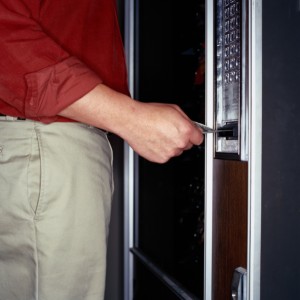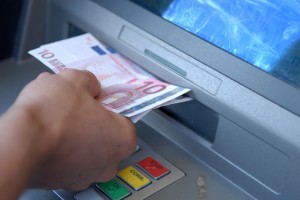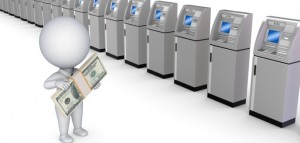Banknotes for Automated Payment Systems
01 June, 2014
(Editor:- this is the first in a Currency News double-shot contribution. With all the news, Awards and good stories out there, we have the good fortune of a stockpile from Currency News. We will be hearing from Astrid again next week!
Planning Note Designs for Automated Payment Systems
 By Robert Morrow, MEI (now part of Crane Payment Innovations) Nearly everybody uses banknotes daily while thinking little about them. Most of us also frequently use ‘Unattended Payment Systems’. Whether you are buying a soda from a vending machine, paying for groceries at a self check-out terminal, or playing your favorite slot machine, you are interacting with an unattended payment system.
Nearly everybody uses banknotes daily while thinking little about them. Most of us also frequently use ‘Unattended Payment Systems’. Whether you are buying a soda from a vending machine, paying for groceries at a self check-out terminal, or playing your favorite slot machine, you are interacting with an unattended payment system.
But, what exactly are they?
Simply put, they are ‘any system that can complete a cash transaction WITHOUT human interaction’. The Greek inventor Heron is commonly credited with inventing the first coin-accepting machine more than 2,000 years ago. It would take a bit longer for a machine to accept paper currency. When I worked at ARDAC in the 1990s, I saw one of the earliest validators from the 1960s that used a light bulb, image mask and vacuum to validate and secure a note. I also had the privilege to work with its inventor. We have come a long way since then.
Unique Challenges
Even with all the advances in technology, systems today still face many challenges that are unique to our segment of the cash handling industry. For example, human cash handlers have the ability to examine a note to determine its intrinsic characteristics. Humans also have the capacity to segregate worn, damaged and ‘end of life’ notes.
Machines lack this innate sense o judgment and the delicate touch. Machines simply pull in whatever is introduced and try to validate it. If a machine is not able to validate a note, it simply returns it. It does not keep it, question the customer or contact law enforcement.
Because of this, machines are often considered a low-risk target for counterfeiters. This allows the opportunity to keep trying and perfect their technique.
Machines are also confronted with several other forms of cheating attempts. This includes notes that are part counterfeit part genuine, as well as cheats where criminals attempt to mechanically retrieve their notes after credit has been issued.
Our products can be placed indoors or outdoors anywhere from the equator to the Arctic Circle. They are expected to work continuously with minimal maintenance for years. Many expect that they should accept nearly 100% of genuine notes and reject 100% of counterfeits. If a machine accepts even a single counterfeit, it becomes a great concern for the owner because the perpetrator may return with more.
In addition to providing high security, our equipment needs to process notes regardless of condition, without jamming. If notes jam inside a machine, it is no longer generating revenue for the owner and it now requires a technician visit. In some cases, machines have been destroyed by angry customers to retrieve a single jammed $1.
 Introduction of New Notes
Introduction of New Notes
Another unique challenge for our industry is the introduction of new notes. When new notes are introduced, there is generally a public education campaign. Machines do not benefit from this and need to have their firmware updated manually. For end-users such as casinos, it may be merely an inconvenience since hey have technical staff on hand and the machines are all in a small area. For self check-out terminal operators in retail stores, this becomes more of a financial burden because it requires sending a technician to each store to update a few machines at each location. For vending machine operators, this is a much greater expense because they tend to be smaller companies without a large technical staff, and their machines are spread over a much larger area.
Even if updated firmware is provided free of charge, the costs to update can leave the end-users weighing the costs and benefits of doing an immediate update or waiting for ‘the next new note’. Waiting may reduce sales by rejecting new notes, but this allows them to reduce the number of times they need to dispatch – thereby reducing operating costs. This is worth noting because some issuing authorities prefer to issue one denomination every few months or so; however, some choose to issue a new series all at once, which is by far the most cost-effective both for our industry as well as our customers.
Well-Defined Steps
In order to create a programme for a new note, there is a well-defined set of steps that define the time needed to prepare before it enters circulation. The first step is to know that a new note is planned, do administrative work and to obtain samples. These are known as test decks. This can take 3-4 weeks. Then, the new notes are measured with each product for which a new programme will be created. The mathematicians then do the statistical analysis on the data and create a profile with some defined tolerances.
The next step is to test the programme under the various environmental conditions the product will be exposed to (hot, cold, low and high humidity etc) as well as adversarial testing (two months).Once a company has created, tested and approved a programme, it can be sent to our customers for their testing (one month). If the programme is to be used in government applications or casino gaming, it may need to be sent to an independent lab for further regulatory approvals before they can release it to their end-users (one month). At this point, the end-users can begin updating their machines (one month).
These time estimates assume little or no backlog in the testing queues. A programme can require changes if it fails anyone of these steps. If all goes well, the process should be completed in about six months. MEI creates programmes that work for more than 120 unique currencies. Each currency has a minimum of five paper/polymer denominations. With an average of ten years between designs for each currency, that is about 60 new notes per year. As you can see, there is a lot of work to do and good scheduling is essential.
 BEP Stands Out
BEP Stands Out
Although many banks now provide test decks to the industry, the US Bureau of Engraving and Printing has stood outwith the quantity and quality of variations they provide in their test decks. As an example, when the new $100 notes were released in 2013, the programme created from the 2010 test deck required NO CHANGES to accept the new notes.I f production notes have more variation than the test notes, it may be necessary to do a ‘re-study’ to adjust the statistics. Because of this, it is critical that the test decks reflect as much of the natural printing variations as possible.
Also worth noting is that counterfeit notes and genuine notes of varying degrees of fitness are available for testing purposes through the Federal Reserve Bank of Richmond’s Currency Technology Office (CTO). This has proven to be a valuable service for our industry.
Since products in our industry tend to be on the lower end of the cost spectrum, we do not have the same amount of memory and processing power as large sorters. This requires us to be very clever with our methods of validating bank-notes. This means that we can typically process a maximum of two banknotes per second and not be able to validate every feature on every note. This is why it is important to have quality, robust Level 2 features distributed around a note that are cost-effective to detect.
Unplanned Changes
Other challenges include multiple series of notes and unplanned changes. Multi-series notes consume memory and can lead to other issues validating notes. Unplanned (or undisclosed) changes to materials or processes are too common an occurrence and can cause even new notes to be rejected
Sometimes intentional changes are not communicated to our industry. This is a huge gamble. There are more than 50 companies producing banknote validation products for counting, sorting and unattended payment systems. Each uses different criteria to determine authenticity. If a feature that we use changes, we may need to do an emergency re-evaluation of the notes. This will include determining what changed and trying to collect problem notes from circulation to update the programme. This can cause huge expense to multiple segments of our industry.
Fit for Purpose
Because of these and other challenges, our goal is to work with central banks discussing what works well for our industry and what does not. This can include collaboration on features as well as the note introduction process itself. Some banks have been willing to work with us and some are still not comfortable with this. At the end of the day, banknotes should be ‘fit for purpose’.
For the public this means they should be able to identify and use the notes inhuman transactions as well as in unattended payment systems the first day they enter circulation. For us, this means the Level 2 features must be reliable and cost-effective, because they are our last line of defence against counterfeiters.
Sometimes countries create their own features. These can be excellent features but, due to their cost to detect, few in our industry may use them. Most products in our industry have a price point below US$1,000. Therefore, it simply is not practical to implement sensors for multiple different security features. Because of these challenges, we try to work with issuing authorities to develop and use features that can be detected with common methods.
Overall, the relationship between the issuing authorities and our industry is the best it has ever been. This can be attributed to a higher level of trust and cooperation within the industry, and I would like to say a personal thank you to all that have worked with us to get to this point.










